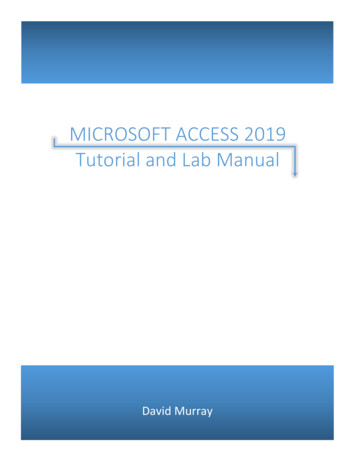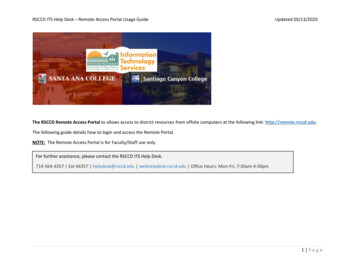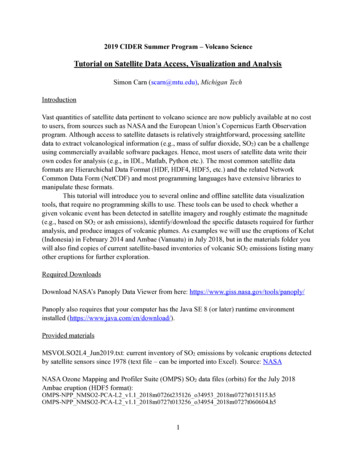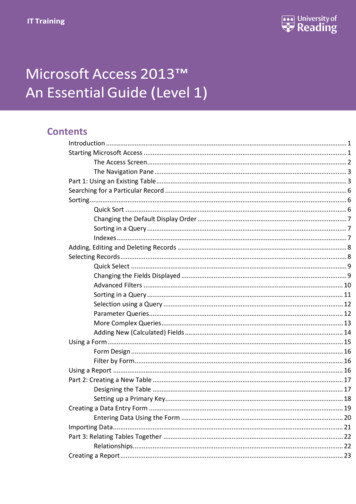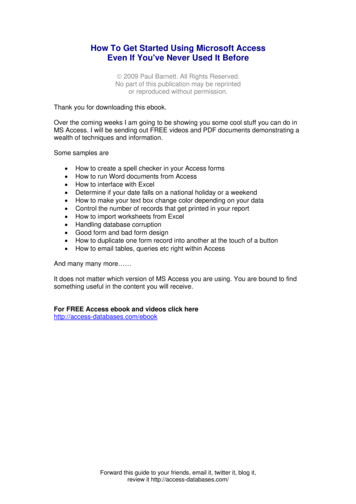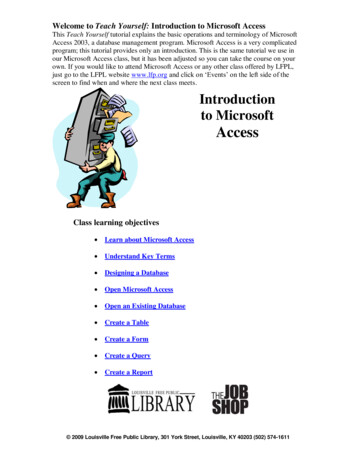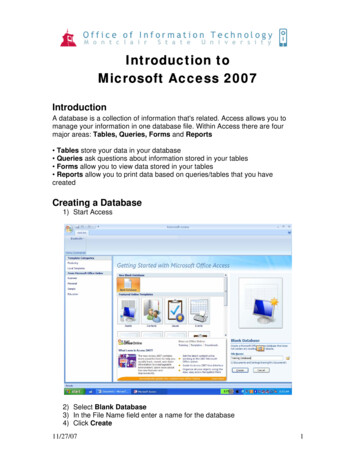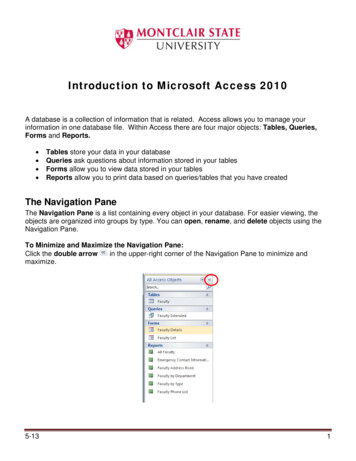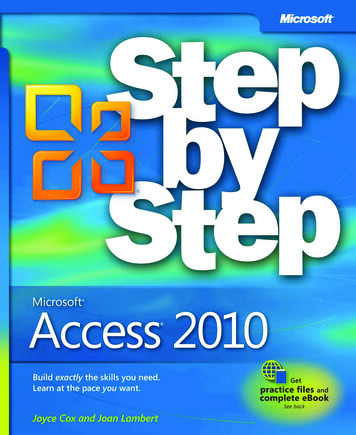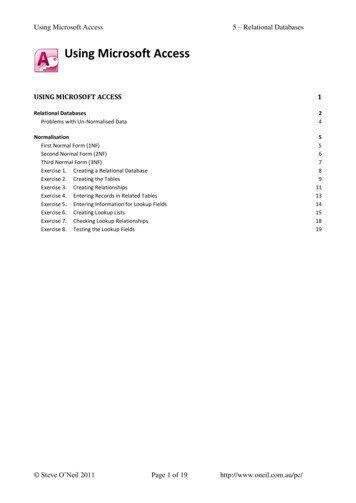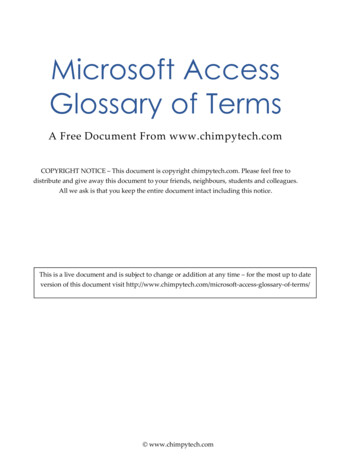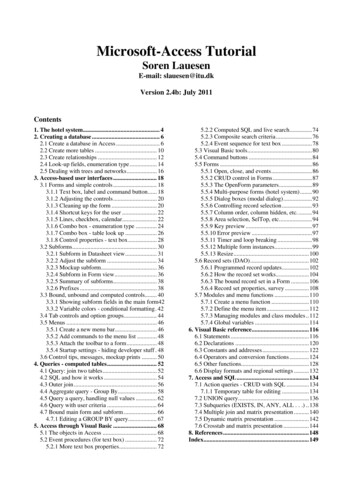
Transcription
Microsoft-Access TutorialSoren LauesenE-mail: slauesen@itu.dkVersion 2.4b: July 2011Contents1. The hotel system. 42. Creating a database . 62.1 Create a database in Access . 62.2 Create more tables . 102.3 Create relationships . 122.4 Look-up fields, enumeration type . 142.5 Dealing with trees and networks. 163. Access-based user interfaces . 183.1 Forms and simple controls. 183.1.1 Text box, label and command button. 183.1.2 Adjusting the controls. 203.1.3 Cleaning up the form . 203.1.4 Shortcut keys for the user . 223.1.5 Lines, checkbox, calendar. 223.1.6 Combo box - enumeration type . 243.1.7 Combo box - table look up . 263.1.8 Control properties - text box. 283.2 Subforms. 303.2.1 Subform in Datasheet view. 313.2.2 Adjust the subform . 343.2.3 Mockup subform. 363.2.4 Subform in Form view. 363.2.5 Summary of subforms. 383.2.6 Prefixes . 383.3 Bound, unbound and computed controls. 403.3.1 Showing subform fields in the main form423.3.2 Variable colors - conditional formatting. 423.4 Tab controls and option groups. 443.5 Menus . 463.5.1 Create a new menu bar. 463.5.2 Add commands to the menu list . 483.5.3 Attach the toolbar to a form. 483.5.4 Startup settings - hiding developer stuff . 483.6 Control tips, messages, mockup prints . 504. Queries - computed tables. 524.1 Query: join two tables. 524.2 SQL and how it works . 544.3 Outer join . 564.4 Aggregate query - Group By. 584.5 Query a query, handling null values . 624.6 Query with user criteria . 644.7 Bound main form and subform . 664.7.1 Editing a GROUP BY query. 675. Access through Visual Basic . 685.1 The objects in Access . 685.2 Event procedures (for text box) . 725.2.1 More text box properties. 725.2.2 Computed SQL and live search.745.2.3 Composite search criteria.765.2.4 Event sequence for text box .785.3 Visual Basic tools.805.4 Command buttons .845.5 Forms .865.5.1 Open, close, and events.865.5.2 CRUD control in Forms .875.5.3 The OpenForm parameters.895.5.4 Multi-purpose forms (hotel system).905.5.5 Dialog boxes (modal dialog).925.5.6 Controlling record selection.935.5.7 Column order, column hidden, etc. .945.5.8 Area selection, SelTop, etc.945.5.9 Key preview .975.5.10 Error preview .975.5.11 Timer and loop breaking .985.5.12 Multiple form instances.995.5.13 Resize.1005.6 Record sets (DAO).1025.6.1 Programmed record updates.1025.6.2 How the record set works.1045.6.3 The bound record set in a Form .1065.6.4 Record set properties, survey .1085.7 Modules and menu functions .1105.7.1 Create a menu function .1105.7.2 Define the menu item.1125.7.3 Managing modules and class modules .1125.7.4 Global variables .1146. Visual Basic reference.1166.1 Statements .1166.2 Declarations .1206.3 Constants and addresses.1226.4 Operators and conversion functions .1246.5 Other functions.1286.6 Display formats and regional settings .1327. Access and SQL.1347.1 Action queries - CRUD with SQL .1347.1.1 Temporary table for editing .1347.2 UNION query.1367.3 Subqueries (EXISTS, IN, ANY, ALL . . .) .1387.4 Multiple join and matrix presentation .1407.5 Dynamic matrix presentation .1427.6 Crosstab and matrix presentation .1448. References.148Index.149
Printing instructionsPrint on A4 paper with 2-sided printing so that text and associated figures are onopposing pages.Version 1: October 2004.Version 2.1: November 2004. Changes:a. Restructured section 3.2 with small additions.b. Section 7.1 on action queries added.c. Small changes and additions to Chapter 6 with corresponding changes in theReference Card.d. Index providedVersion 2.2: April 2004. Changes:a. SQL HAVING introduced in section 4.2 and the example in section 4.4.b. More on aggregate functions in section 4.4.c. ColumnOrder, ColumnWidth discussed in section 5.5.7.d. Selection of an area in the datasheet is discussed in section 5.5.8.e. Section 5.7 (action queries) now moved to Chapter 7.f. Action queries, Union, Subqueries, Crosstab, etc. discussed in Chapter 7 (a newchapter).g. Various small changes and improved explanations here and there.Version 2.3: September 2006. Changes:a. Access 2003 dialog when opening a database changed (page 8).b. Look-up fields for foreign keys deleted (last part of section 2.4). Access'sautomatic creation of relationships caused too much confusion.c. Combo boxes described in sections 3.1.6 and 3.1.7.d. More events explained in section 5.2.3.e. Various misprints corrected.Version 2.4: August 2007 and July 2011. Changes:a. Partial integrity (page 12).b. Adding a label to a control (page 20).c. DateTime Picker (page 22).d. More Null rules (page 62, 77, 124).e. Access data model and experiments improved (page 68-70).f. Composite search criteria, more computed SQL, date comparison (page 76-77).g. Event sequence for textbox: small corrections, e.g. OldValue (page 78).h. Improved area selection (page 95-96).i. Error handling, user errors (page 97-98).j. Timer and loop breaking (page 98-99).k. Managing modules and class modules (page 112).l. Error handling, VBA errors, Err object (page 117).m. Enum type (page 121).n. Partition operator (page 124).o. Week number in the Format function (page 126).p. Dynamic matrix simplified (page 136).q. Minor corrections and improvements in many places.r. Version 2.4a: Note on AutoNumber added to Figures 2.1C and 2.4.s. Version 2.4b: Copyright notice more liberal. Misprint corrected (page 65, step14 and 15). Figure 52B (page 75) shows quote-stuff more clearly. SendKeys onpage 99 elaborated. Soren Lauesen, 2007Permission is granted to use, print and copy the file on a non-profit basis as long asthe source is clearly stated. The document is available on the author's web site onthese conditions.2Preface
PrefaceThis booklet shows how to construct a complex application in Microsoft Access (MS-Access). We assumethat the user interface has been designed already as apaper-based mockup (a prototype). How to design agood user interface is a separate story explained inUser Interface Design - a Software Engineering Perspective, by Soren Lauesen.6. Visual Basic reference. A reference guide to theVisual Basic language for Applications (VBA).7. Access and SQL. An overview of the remainingparts of SQL, for instance how to update thedatabase through SQL. We also explain how togenerate matrices of data with dynamically changing headings.After design, development continues with constructingthe database, constructing the user interface, bindingthe user interface to the database, and finally developthe program. This is what this booklet is about.The reason we illustrate the construction process withMS-Access is that it is a widely available tool. Anybody who has Microsoft Office with MS-Word, alsohas Access and the programming language Visual Basic behind Access.MS-Access is also a good illustration of many principles that exist on other platforms too, for instance a relational database, a Graphical User Interface (GUI),event handling, and an object-oriented programminglanguage. MS-Access contains all of these parts - cooperating reasonably smoothly.Using the booklet for teachingWe have experimented with using the booklet forteaching. First we tried to present part of the materialwith a projector, then let the students try it out on theirown, next present some more, etc. Although thestudents listened carefully, it turned out to be a wasteof time, partly because the students worked with vastlydifferent pace.Now we give a 15 minute introduction to the mainparts of Access: the database window, the tables, theforms - and how they relate to what they have learnedin user interface design. Then the students work ontheir own. We have instructors to help them out whenthey get stuck.The hotel systemWe have chosen to illustrate the construction processwith a hotel example, because most people have anidea what it is about, yet it is sufficiently complex toshow typical solutions in larger systems. Some of thecomplexities are that a hotel has many types of roomsat different prices; a guest can book several rooms,maybe in overlapping periods; a room may need renovation or repair, making it unavailable for a period; thehotel keeps track of regular guests and their visits overtime.Organization of the bookletThe chapters in the booklet are organized like this:1. An introduction to the hotel system that is used asan example throughout the booklet.2. Creating a database. Construct a database that corresponds to the data model behind the design. Theuser will only see the database indirectly - throughthe screens we construct.3. Access-based user interfaces. Construct the screensand menus that the user will see. We follow the paper-based mockup designed in User Interface Design. You can use the result as a tool-basedmockup.4. Queries - computed tables. Connect the screens tothe database, usually by means of queries - computed data tables. The result will be a partiallyfunctional prototype.5. Access through Visual Basic. Program what thebuttons and menus will do when the user activatesthem. The result will be a fully functional prototypeand later the final system to be delivered to thecustomer. The first part of the chapter is tutorial mandatory reading if you want to work with VisualBasic and Access. The rest of the chapter is forlooking up various subjects. We assume you knowa bit of programming already.PrefaceSimplificationsHowever, we have simplified the system in many otherways to shorten the discussion. For instance we ignorethat in most hotels, rooms are not booked by roomnumber, but by room type; hotels usually overbook, i.e.book more rooms than they have, expecting that somecustomers will not turn up. We also ignore all the otheraspects of operating a hotel, for instance keeping trackof when rooms are cleaned and ready for the nextguest, purchasing goods, planning who is to be on dutyfor the next weeks, payroll and general accounting. Inspite of these simplifications, the example still showsthe structure of larger systems.On-line resourcesA demo-version of the hotel system, a VBA referencecard, etc. are available from the authors's web site:www.itu.dk/people/slauesen. Comments are welcome.Soren Lauesen, slauesen@itu.dk3
1. The hotel systemIn this booklet we illustrate MS-Access by means of asystem for supporting a hotel reception. The system isused as the main example in User Interface Design - aSoftware Engineering Perspective, by Soren Lauesen.If you know the book, skip this section and go straightto Chapter 2.ScreensThe hotel system consists of the screens shown in Figure 1A.Find guest. The Find guest screen allows the receptionist to find a guest or a booking in the database. Thereceptionist may enter part of the guest name and clickthe Find guest button. The system then updates thelower part of the screen to show the guests or bookingsthat match. The receptionist may also find the guest byhis phone number, room number, or stay number (alsocalled booking number).The receptionist can select the guest from the list andclick the buttons to see details of the booking or createa new booking for the guest.Room Selection. The Room Selection screen gives anoverview of available rooms in a certain period. Availability is shown as IN when the room is occupied,BOO when it is booked, etc. The receptionist mayspecify the period of interest and the type of room, thenclick the Find room button. The system updates the table at the bottom of the screen to show the rooms ofinterest. The receptionist can then choose a room andbook it for the guest – or check a guest into the room.Sta
MS-Access is that it is a widely available tool. Any-body who has Microsoft Office with MS-Word, also has Access and the programming language Visual Ba-sic behind Access. MS-Access is also a good illustration of many princi-ples that exist on other platforms too, for instance a re-lational database, a Graphical User Interface (GUI),File Size: 2MBPage Count: 154
